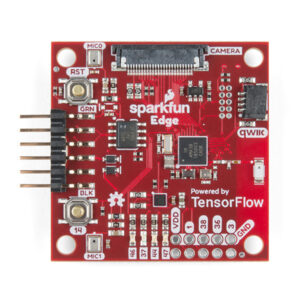 The SparkFun Edge, a new development board powered by Apollo3 from Ambiq, is now shipping from SparkFun.com. The SparkFun Edge was created in collaboration with Google’s TensorFlow Lite team to create new tools for developers to bring voice and gesture recognition to edge devices. The Apollo3 from Ambiq uses a Cortex M4 processor with 384KB of RAM and 1MB of Flash storage, requiring extremely low levels of power and allowing the SparkFun Edge to run for several days on a coin cell battery. SparkFun Founder, Nathan Seidle, and Google Engineer, Pete Warden, will be hosting livestream at 11am Mountain Time on Friday, April 5, 2019 (https://www.youtube.com/
The SparkFun Edge, a new development board powered by Apollo3 from Ambiq, is now shipping from SparkFun.com. The SparkFun Edge was created in collaboration with Google’s TensorFlow Lite team to create new tools for developers to bring voice and gesture recognition to edge devices. The Apollo3 from Ambiq uses a Cortex M4 processor with 384KB of RAM and 1MB of Flash storage, requiring extremely low levels of power and allowing the SparkFun Edge to run for several days on a coin cell battery. SparkFun Founder, Nathan Seidle, and Google Engineer, Pete Warden, will be hosting livestream at 11am Mountain Time on Friday, April 5, 2019 (https://www.youtube.com/
“Academia has been talking about artificial intelligence for decades, and while the field has made amazing strides, there haven’t been many tangible effects for general users. With exciting new tools like TensorFlow for machine learning, and increasing processing power, we are starting to see improvements that we can begin to reap benefits from,” said Seidle.
“We wanted to show examples of TensorFlow running on embedded systems at a super-low-power—we needed a tool to do that. We talked with SparkFun and Ambiq and now we are able to share this device with the world,” said Pete Warden.
The utilization of Ambiq Micro’s latest Apollo3 Blue microcontroller, an ultra-efficient ARM Cortex-M4F 48MHz (with 96MHz burst mode) processor, runs TensorFlow Lite using only 6uA/MHz. Apollo3 Blue sports all the cutting edge features expected of modern microcontrollers including six configurable I2C/SPI masters, two UARTs, one I2C/SPI slave, a 15-channel 14-bit ADC, and a dedicated Bluetooth processor that supports BLE5. On top of all that the Apollo3 Blue has 1MB of flash and 384KB of SRAM memory – plenty for the vast majority of applications.
On the SparkFun Edge, developers will have built-in access to sensors, Bluetooth, I2C expansion, and GPIO inputs/outputs. To support edge computing cases like voice recognition the Edge board features two MEMS microphones, an ST LIS2DH12 3-axis accelerometer on its own I2C bus, and a connector to interface to an OV7670 camera (sold separately). An onboard Bluetooth antenna gives the Edge out-of-the-box connectivity. Also available on the board is a Qwiic connector to add I2C sensors/devices, four LEDs, and four GPIO pins. To boast its low-power capabilities, the board is outfitted with battery operation from the CR2032 coin cell holder. Programming the board is taken care of with an external USB-serial adapter like the Serial Basic Breakout via a serial bootloader, but for more advanced users the board also includes JTAG programming and a debugger port.
As an entirely open-source project, developers can take a look at the code and hardware files on GitHub and at SparkFun.com.
Orders for the SparkFun Edge can be placed at SparkFun.com.

Leave a Reply